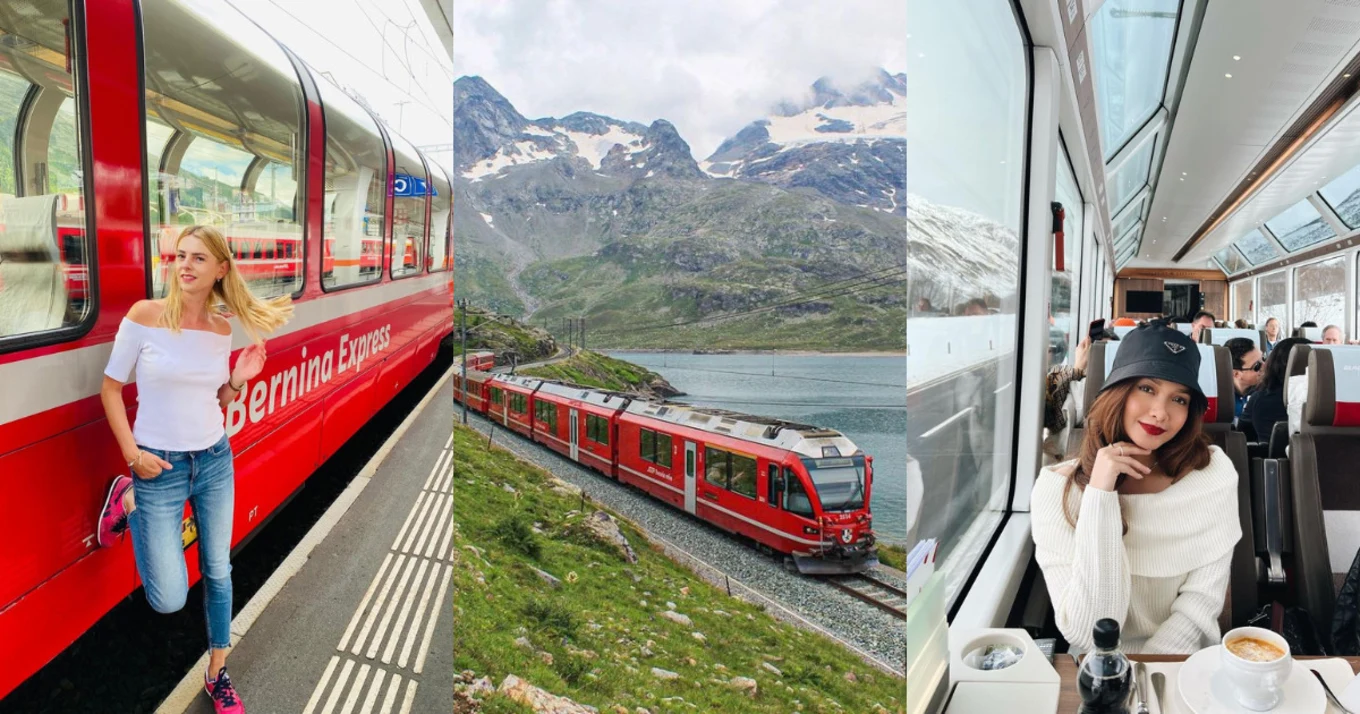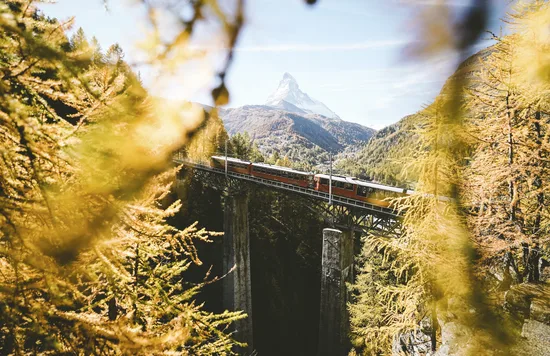Switzerland, home of decadent Swiss chocolate and the scenic, snow-capped Swiss Alps, is the ultimate sightseeing destination. It also has a top-notch transportation system, complete with well-connected train networks and a system of buses and boats that can take you anywhere you wanna go.
The best part of Switzerland's trains? More than just a mode of transport, they're also excellent for sightseeing! Behold breathtaking natural sights as you traverse the country's grassy lands, snow-capped mountains with glaciers peeking through, and flowering rivers aboard its panoramic trains that offer the best seats to witness everything.
Two of the most scenic train journeys are the Bernina Express and Glacier Express, often competing for the title of the best panoramic sightseeing train. But with the Swiss Travel Pass (STP), you can have the best of both worlds—and more!
With the pass, you can access unlimited rides on local trains, trains with panorama cars, boats and buses, including the Glacier and Bernina Express. Say bye-bye to buying multiple train passes! You can also enjoy discounts when you get tickets for the Jungfraujoch, Glacier 300, Gornergrat, and Harder Kulm from Klook!
If you're wondering whether you want to ride the Glacier or Bernina Express, we've got you covered. Though it's definitely better to try both, we've conjured up a handy comparison guide to help you decide:
What is the Bernina Express?
The Bernina Express is a narrow gouge train run by the Rhätische Bahn equipped with panorama cars with side windows, designed for a better viewing experience compared to regular commuter trains. The Bernina Express route is known to be one of the most scenic, with only the Glacier Express as its rival.
The Bernina Express operates year-round so you can enjoy the snow-covered Alps and landscapes in the winter, as well as the lush greenery in spring and summer. Fun fact: the Bernina Express runs along a railway line now considered a UNESCO World Heritage site that was built from 1896 to 1904!
What is the Glacier Express?
Like the Bernina Express, Glacier Express is also a narrow-gauge train, but it's billed as Europe's slowest express—but worth it for the scenic views! It's a regularly scheduled train operated by the Glacier Express AG, which was formed by two private Swiss railways, the Matterhorn Gotthard Bahn (MGB) and the Rhätische Bahn (RhB), and runs between the Swiss municipality of Zermatt and the town of St. Moritz. It also has huge panoramic side windows and glass skylights, so no breathtaking scenery is obstructed!
Where does the Bernina Express start and end?
The Bernina Express route begins in Chur, Switzerland, and ends in Tirano, Northern Italy. It also shares a route with the Glacier Express, specifically between Chur and Samedan, the latter of which is near St. Moritz. The Bernina Express crosses the famous Landwasser Viaduct to get from one mountainside to the other. At the South of Pontresina, the train ascends to Bernina Pass, past the Mortetratsch Glacier.
Then it ascends even higher to reach its highest point: Ospizio Bernina, impressively located 2,253 metres (7,391 feet) above sea level. From the other side of this point, you'll descend and wade through fir trees to the village of Poschiavo. Finally, between Poschiavo and the Italian town of Tirano, you'll run around the famous Brusio Spiral Viaduct, a famous photo spot where most of the classic Bernina Express publicity photos are taken. Remember to keep your cameras within reach for that IG-worthy shot!
Such impressive sights—what can you expect from the Bernina Express railway line, a UNESCO World Heritage site?
Where does the Glacier Express start and end?
The long journey on the Glacier Express begins at Zermatt, at the foot of the iconic Matterhorn. Then you'll traverse a whopping number of 291 bridges and 91 tunnels before you reach St. Moritz in the Engadin skiing area. After departing at Zermatt, the train will descend to Mattertal Valley, located 1,804 metres above sea level. Then it will pass through Brig and Rhône Valley, which showcases mountains, snow-laden fir trees, and whimsical Swiss villages.
You'll stop over at Andermatt, ascend to the dramatic Oberalppass (which is at 2,033 metres above sea level), descend to Disentis, pass the wonderful Rhine Gorge, cross the photogenic Landwasser Viaduct (same as the Bernina Express route), and finally the train climbs to St. Moritz (1,775 metres above sea level).
Want to explore more destinations with your STP? Check out this guide to Switzerland's top attractions or this one-week alpine itinerary:
How many hours does it take to traverse the Bernina Express route?
It takes the Bernina Express four hours to traverse the 144 km (90 miles) between Chur to Tirano.
How many hours does it take to traverse the Glacier Express route?
It takes 7½ hours to cover over 290 km (180 miles) of the Glacier Express at an average of around 24 mph.
What is riding the Bernina Express like?
Prepare for an incredible journey on the Bernina Express, where you'll traverse 55 tunnels and cross 196 bridges, experiencing an Alpine gradient as steep as 1 in 7! Enjoy the scenic beauty of Switzerland through the panoramic windows and the roomy, comfy seats. The four-hour ride will be a breeze!
During the ride on the Bernina Express, you can treat yourself to refreshments like coffee, tea, and fizzy drinks, served directly in your seat. You can also munch on traditional dried sausage and cheese if you're feeling peckish. Like most European trains, however, you can also bring your own food. One thing's sure: there won't be any hungry stomachs on the Bernina Express!
What is riding the Glacier Express like?
The Glacier Express is known to be a comfortable mode of Swiss travel. As soon as you step aboard, you'll be greeted by panorama cars adorned with plush carpeting and air conditioning. The signature skylight lets you soak in as many of the views as possible. You can settle onto the spacious seats for extra comfort during the almost eight-hour ride. There’s also a restaurant car serving up delicious food and drinks to satiate your thirst and hunger.
What are the scenic highlights of the Bernina Express?
The Bernina Express promises stunning scenery at every turn, but there are notable highlights along the way. As you pass through Domleschg, prepare to enter a bygone era of enchanting castles. Then make sure to keep your cameras ready for the Landwasser Viaduct, which is iconic for being the spot where the Bernina Express is often photographed. But the excitement doesn't stop there!
Brace yourself as the Bernina Express reaches its highest point at Ospizio Bernina, a staggering 2,253 meters (7,391 feet) above sea level.
The Bernina Express will also take you to Alp Grüm station in Poschavio, where you'll find a popular photo op spot with the Swiss landscape as the backdrop!
What are the scenic highlights of the Bernina Express?
The Glacier Express route is riddled with idyllic mountain villages. From the moment you depart for Zermatt, you'll be charmed by each destination along the way. You'll first venture towards St. Niklaus and Kipfen Gorge to Brig, an alpine town in Valais at the foot of Simplon Pass.
Another highlight of the trip is Adermatt, nestled in the Ursern Valley, which is a popular tourist destination with an excellent selection of hotels, like The Chedi. It's also home to Ski Arena, the largest ski resort in Central Switzerland. You'll also see the highest peak of Glacier Express: Oberalppass, which sits at 2,033 meters above sea level, offering unforgettable views.
Then the train will descend to the small town of Disentis, which is part of the Ski Arena Andermatt-Sedrun region. As in the Bernina Express route, the train will traverse Landwasser Viaduct. The Glacier Express also covers the Rhine Gorge, a.k.a “Grand Canyon of Switzerland.”
Does the Swiss Travel Pass cover the Glacier and Bernina Express?
It does cover both the Glacier and Bernina Express!
Where can I book a Swiss Travel Pass?
Psst—we've got a hack for you...you can quickly and easily book your Swiss Travel Pass on Klook! This covers both the Glacier and Bernina Express. Sounds awesome, right?
Booking your pass is simple. You can choose between a Flexible Pass or a Consecutive Pass. With the Flexible Pass, you can conveniently use your STP on the days you choose within a month of activation. On the other hand, the Consecutive Pass provides continuous validity for the selected number of days starting from the date you've selected.
Then you can use your travel pass to book the Bernina Express:
- Step 1: First, visit the Bernina Express official website. There you can input your train journey details. It's highly recommended to book early, as trains can be sold out quickly!
- Step 2: Then, you can choose the train and seats
- Step 3: Input your personal details; make sure to choose Swiss Travel Pass under the Reduction tab to enjoy the discounts
- Step 4: Finally, you can pay, and you're all set! You'll receive the ticket, which you'll present upon boarding the Bernina Express
You can also use it to book the Glacier Express:
- Step 1: Similar to Bernina Express, you first have to visit the Glacier Express official website, where you can select your train journey and input your train journey details
- Step 2: Then you can choose the train and seats
- Step 3: Input your personal details; make sure to choose Swiss Travel Pass under the Reduction tab to enjoy the discounts
- Step 4: Select your meal option
- Step 5: Proceed to payment with discounts, and you are set to go! You'll receive the ticket, which you'll present upon boarding the train
Now that you know all about the Glacier and Bernina Express, have you decided which one you'll want to ride? Either way, you'll be in awe of the endless breathtaking scenes! So, are you game to take the scenic route through Switzerland? The Glacier and Bernina Express routes will serve sights—both of which you can access with the Swiss Travel Pass!
Want to extend your Swiss journey to the rest of Europe? Then you can get the Eurail Global Pass, a single document that lets you travel across 33 European countries without needing to purchase multiple train passes! To know more about this handy pass, here's our guide to the different types of Eurail Passes and the trains you can ride using them.
Written by: Rohana Monzon

























![[Updated] Complete List Of Official Nationwide MCO SOP 2021](https://res.klook.com/image/upload/fl_lossy.progressive,q_85/c_fill,w_160,h_104/v1633858858/blog/iso56uzsphmdguixkvzh.webp)





![[Updated] Complete List Of Official Nationwide MCO SOP 2021](https://res.klook.com/image/upload/fl_lossy.progressive,q_85/c_fill,w_410,h_264/v1633858858/blog/iso56uzsphmdguixkvzh.webp)







